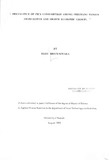| dc.description.abstract | An interesting phenomenon has been observed amongst pregnant women world wide,
spanning over a number of decades; This is the consumption of non-food substances like
soil, clay, chalk and many others. This practice is known as pica. A cross sectional study
was carried out in Nakuru Municipality to determine the prevalence of pica consumption
amongst pregnant women of different socio-economic groups. The factors considered ill
the study were:- Socio-economic status (SES), dietary patterns, types of substances
consumed, mineral elements present in these substances, reasons for consumption,
amounts ingested and problems associated with pica consumption.
A total of 422 pregnant women at all stages of pregnancy, were identified and studied. The
investigation involved administration of a questionnaire and analysis of mineral contents of
selected pica samples. The overall prevalence of pica consumption amongst the pregnant
women in the study area was 45%. There was no relationship between socio-economic
status and pica consumption, nor was consumption influenced by previous exposure.
Results showed that pica consumption begins mainly during the second trimester, a time
when maternal nutritional needs are said to be on the increase. The types of substances
consumed were mainly earth substances and the most common were loose soil, roasted
clay, termite clay and construction stones dug out of quarries. On analysis, these
substances yielded some mineral elements that could be of use to the body like calcium,
iron and potassium among others. From the reasons given by the women as to why they
consume pica substances, it was not easy to establish the real cause for this practice and
therefore more research is needed in this area. | en |

